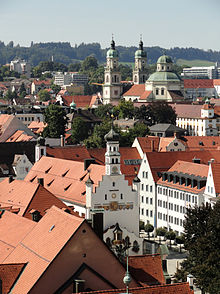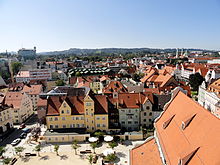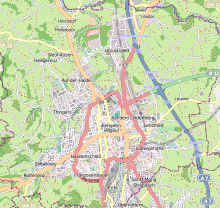Kempten
![]()
Kempten is a redirect to this article. For other meanings see Kempten (disambiguation).
Kempten (Allgäu) (Swabian![]() ) is an independent city with over 70,000 inhabitants in the Allgäu region in the Bavarian administrative district of Swabia. It is the upper, school and administrative centre of the surrounding economic, holiday and planning region Allgäu with about 470,000 inhabitants. Kempten is the second largest city in the administrative district after Augsburg and is considered one of the oldest cities in Germany, as it was already mentioned in a written document in ancient times. Kempten has increasingly been referred to as an Allgäu town since the 1930s, yet a Swabian rather than an Allgäu dialect is spoken there, the latter of which can only be detected to any discernible extent south of Immenstadt in the Allgäu.
) is an independent city with over 70,000 inhabitants in the Allgäu region in the Bavarian administrative district of Swabia. It is the upper, school and administrative centre of the surrounding economic, holiday and planning region Allgäu with about 470,000 inhabitants. Kempten is the second largest city in the administrative district after Augsburg and is considered one of the oldest cities in Germany, as it was already mentioned in a written document in ancient times. Kempten has increasingly been referred to as an Allgäu town since the 1930s, yet a Swabian rather than an Allgäu dialect is spoken there, the latter of which can only be detected to any discernible extent south of Immenstadt in the Allgäu.
The townscape is characterised by the centuries-long coexistence of two town centres: on the one hand the so-called collegiate town of the Kempten prince abbey, on the other hand the imperial town of Kempten. The contrasting ground plan and layout, which can still be seen today, makes Kempten a double town.
The Kempten University of Applied Sciences has been located in Kempten since 1977 and has almost 6000 students enrolled. This makes it one of the largest universities of applied sciences in Bavaria.
This medium-sized town lies on the border with the Austrian states of Tyrol and Vorarlberg.

View from the nearby Mariaberg, in the background Wetterstein mountains, with Zugspitze (right)

View from the tower of the St.-Mang-Church to the town hall square with the town hall and to the Basilica St. Lorenz with a part of the Residence in the background

View from the tower of the St.-Mang-Church towards the west

General map of the city of Kempten (Allgäu)
.jpg)
The Hildegardplatz with the Basilica St. Lorenz and the Prince Abbot's Residence
Place name
Kempten is occasionally referred to in the media as the capital of the Allgäu, the Allgäu metropolis or the Illerstadt.
Name development
In a writing around the birth of Christ, the geographer Strabon mentioned a place Καμβοδουνον (Kambódounon) or Kandodounon as a city (polis) of the Celtic Estions. On a Budapest tombstone of the 2nd century the name Camboduno has come down to us, and in the same form the name is found on Peutinger's tablet. Campoduno is attested in the Itinerarium Antonini. In the Notitia Dignitatum the late Roman Cambidano is mentioned. In the 8th to the 9th century the present Kempten was mentioned as Campidona. Examples are Campidonensis cenobium (733) or the monasterium quod dicitur Campidona (889). The German form first appeared as Kemptun in 1263, Kemtun in 1287, Kemptůn in 1293, Kempton in 1295. The form Kemptun still appeared in the 14th century, Kempten for the first time in 1338. Under Otto Merkt the town of Kempten was raised to the status of a city district (kreisfreie Stadt), in the course of which numerous neighbouring hamlets and Einöden of the municipality of Sankt Lorenz, which existed until 1972, were added to Kempten and the addition (Allgäu) was introduced.
Name interpretation
The older derivation of the place name from the male name Cambo is considered disproved. Camb(o) means either "bend", "bay" or "peninsula". The Celtic ending dun(um) is developed phonetically to do, ten and means "castle" or "fortress". So the original form of the name means something like "a castle at the bend or on a peninsula".

enlarge and show information about the picture
![]()
View from the Parkhotel to the old town with pedestrian zone (2010)
Secessions and incorporations
After Kempten became the administrative seat of the Illerkreis in 1802, the administrative seat was moved from Kempten to Augsburg in 1817. In 1818, the two rural communities of Sankt Mang and St. Lorenz were created and separated from Kempten. These two independent communities were not a closed unit, but a rural union. The name for these two settlement unions was not given by the largest part of the community, but by the Kempten city parishes of Sankt Lorenz and Sankt Mang. The city parish churches, however, were not located in the communities, but continued to be in the city of Kempten.
With the decision on 15 December 1971 about a territorial reform to be completed on 1 January 1972, the long-cherished wish of a reunification of Kempten became reality. From then on, St. Lorenz and Sankt Mang belonged to Kempten. The administrative district Kempten (Allgäu) was dissolved on 1 July 1972. It was merged with the district of Sonthofen to form the new, larger district of Oberallgäu.
St. Lawrence
→ Main article: St. Lawrence
The first successful reunification took place in 1869 with the annexation of Schwaighausen, Anwanden and the Fischerösch of St. Lorenz. Smaller incorporations took place from 1904 onwards.
A large cession of territory took place on October 1, 1934, and the community lost a good third of its total area. These were the areas Lotterberg, Reichelsberg, Haubensteig, Stiftallmey, Stadtweiher, Eggen, Haslach, Moos, Seibäumen, Letten, Ellharten, Steufzgen, Stadtallmey, Bucharts, Steinberg, Kaurus, Adelharts, Eich, Moosers, Breiten, Lugemanns, Rottach as well as parts of the areas Oberwang, Unterwang and Halden.
One year later, by a new legal regulation, the areas of Thingers, Rauhen, Ober- und Unterheggers, Staudach, Lauben ob und unter der Bruck, Kindo, Mariaberg, Jägers, Johannisried, Ober- und Unterried, Zur Rottach, Wittleiters as well as some remnants of unincorporated parcels were added to Kempten in 1934. Kempten was then elevated to a city district.
St. Mang
→ Main article: Saint Mang
When in 1900/01 an attempt by residents of Sankt Mang to incorporate the town failed, various minor changes of territory followed in the following years - mainly for strategic and economic reasons. During the Second World War, Kempten made several efforts to incorporate, but without success. Small areas became part of Kempten between 1869 and 1909 as well as in 1937.

Kempten in 1836 before the first incorporations, the railway lines were added in 1851/53: the town of Kempten outlined in green, surrounded by the rural communities of St. Lorenz and Sankt Mang
Search within the encyclopedia